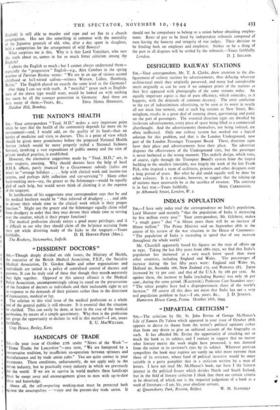DISFIGURED RAILWAY STATIONS
Sta,—Your correspondent, Mr. T. A. Clarke, drew attention to the dis- figurement of railway stations by advertisements, thus defacing whatever
architectural merit they originally possessed, and many had considerable merit originally as can be seen if we compare prints of the stations as they first appeared with photographs of the same stations today. An equally important aspect is that of pure efficiency, which coincides, as it happens, with the demands of common decency. The utter confusion to the eye of indiscriminate advertising, to be seen at its worst in nearly all our main line termini, and at such big stations as New Street, Bir- mingham, results in a great deal of running about, questioning and panic on the part of passengers. The essential direction signs are dwarfed by irrelevant advertisements, every piece of space being filled as a commercial afterthought. And the advertisements themselves, not being isolated, are often ineffectual. Only one railway system has worked out a logical solution for this problem, and that is the London Underground, now part of the London Passenger Transport Board. There, direction signs have their place and advertisements have their place. No advertiser disputes the effectiveness of the Underground sites, but the passenger is never bothered at the wrong moment. This orderly design, which runs, of course, right through the Transport Board's system from the largest building to the smallest timetable, was largely the work of the late Frank Pick, who inspired a team of architects, printers and other designers over a long period of years. But what he did could equally well be done by other railways. It is a mistake, however, to suggest that the tidying-up of stations must necessarily be at the sacrifice of revenue. The contrary


























 Previous page
Previous page